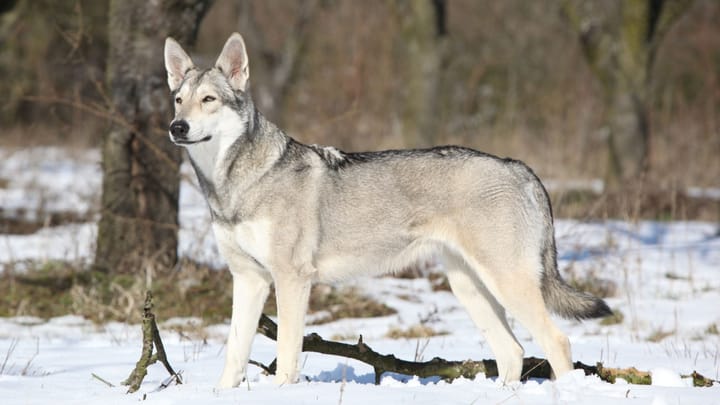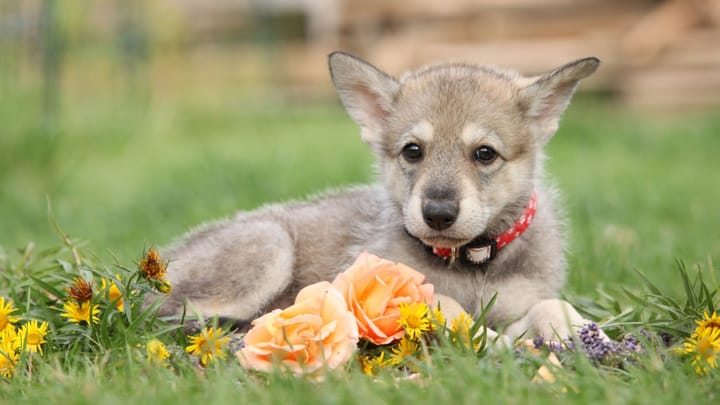Saarloos Wolfhound
Other names : Saarloos Wolfdog, European Wolfdog


The Saarloos Wolfdog is a cross between the German Shepherd and the European Wolf. She is a large, powerful, and athletic dog that still looks very much like a wild wolf. This can be quite intimidating at first, especially for those who are naturally nervous around big dogs. However, the wolfdog is surprisingly calm, and even a little reserved. This is not the outcome breeders were hoping for, but the pairing still created a very unique animal. Despite being a bit of a gentle giant, a wolfdog is not the best choice for inexperienced owners.
|
Life expectancy |
The Saarloos Wolfhound has a life expectancy of between 11 and 13 years |
|
Temperament |
|
|
Size |
Large
|
|
Adult size |
Female
Between 24 and 28 in
Male
Between 26 and 30 in
|
|
Adult weight |
Female
Between 75 and 79 lb
Male
Between 84 and 90 lb
|
|
Coat colour
Grey, white, silver, sand and fawn. |
Sand |
|
Type of coat
Thick, dense, double-layered. |
Long Hard |
|
Eye colour
Yellow. |
Brown
|
The Saarloos is much better suited to living in the countryside, as she needs lots of space to fully express herself.
Some of the Saarloos’s health issues can be very expensive to treat.
She sheds a lot of hair.
More details about the Saarloos Wolfhound
Saarloos Wolfhound: Origins and history
The Saarloos Wolfdog is quite the enigma. Despite being the cross of two fearless animals, the Wolfdog failed to inherit many of their characteristics. She certainly looks the part, but Wolfdogs have a very different personality from either parent breed. She is more reserved than brave, more shy than confident, and more passive than aggressive. This has lead to her kind being used as companion dogs and assistance dogs rather than what they were originally bred for, which was hunting and herding.
Physical characteristics of the Saarloos Wolfhound
The Saarloos Wolfhound is a strongly built dog with a striking resemblance to a wolf. She has pointed ears and almond eyes, and an attentive, though somewhat reserved, expression. The Saarloos is big-boned with a proud posture. She has long shoulders and lean, muscular hindquarters, with a long muzzle and tail. Males are much larger than females.
FCI classification of the Saarloos Wolfhound
-
Group 1 - Sheepdogs and Cattledogs (except Swiss Cattledogs)
-
Section 1 : Sheepdogs
Saarloos Wolfhound: Characteristics
Saarloos Wolfhound: Behaviour
Training a Saarloos Wolfhound
In the right hands, she can be well trained, but a relationship of mutual trust must first be established to get this willful dog on board.
Saarloos Wolfhound: Lifestyle
Breed compatibility Saarloos Wolfhound
Saarloos Wolfhound: Purchase price
Around £800 for a well-bred pedigree puppy. Looking after a dog of this size typically costs between £60 to £90 a month, including food, medical/insurance, and incidental expenses.
Saarloos Wolfhound: Shedding
Average
She sheds moderately, but more heavily during spring and autumn.
Saarloos Wolfhound: Grooming
Fairly low grooming requirements. Two to three quick brushes each week are enough.
Saarloos Wolfhound: Health
This is a generally healthy breed with an average life expectancy of 12 years.
This is a robust animal, who is big, muscular, and very strong. She can develop some hereditary diseases.
She sheds her fur during the warmer months. This helps keep her cool but avoid walkies during the hottest parts of the day.
The Wolfdog was designed to thrive in cold temperatures. A British winter won’t bother this dog.
She is not predisposed to putting on weight.
- Hip dysplasia
- Elbow dysplasia
- Glaucoma
- Cataracts
- Pituitary dwarfism
- Degenerative myelopathy
- Progressive retinal atrophy





